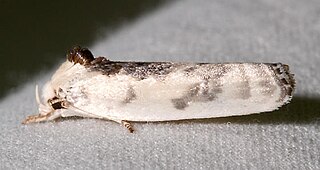
Antaeotricha is a genus of moths. It is the largest genus in the subfamily Stenomatinae, numbering over 400 species in the Western Hemisphere.
Antaeotricha adjunctella is a moth in the family Depressariidae. It was described by Francis Walker in 1864. It is found in Amazonas in Brazil and in the Guianas.
Antaeotricha aratella is a moth in the family Depressariidae. It was described by Francis Walker in 1864. It is found in Amazonas, Brazil.
Antaeotricha basiferella is a moth in the family Depressariidae. It was described by Francis Walker in 1864. It is found in Amazonas, Brazil.
Antaeotricha basirubrella is a moth in the family Depressariidae. It was described by Francis Walker in 1864. It is found in Amazonas, Brazil.
Antaeotricha confixella is a moth in the family Depressariidae. It was described by Francis Walker in 1864. It is found in Amazonas, Brazil.
Antaeotricha conturbatella is a moth in the family Depressariidae. It was described by Francis Walker in 1864. It is found in Amazonas in Brazil and in French Guiana.
Antaeotricha costatella is a moth in the family Depressariidae. It was described by Francis Walker in 1864. It is found in Amazonas, Brazil.
Antaeotricha filiferella is a moth in the family Depressariidae. It was described by Francis Walker in 1864. It is found in Amazonas in Brazil and in Panama.
Antaeotricha graphopterella is a moth in the family Depressariidae. It was described by Francis Walker in 1864. It is found in Amazonas, Brazil.
Antaeotricha impactella is a moth in the family Depressariidae. It was described by Francis Walker in 1864. It is found in Amazonas, Brazil.
Antaeotricha incisurella is a moth in the family Depressariidae. It was described by Francis Walker in 1864. It is found in Amazonas, Brazil.
Antaeotricha indicatella is a moth in the family Depressariidae. It was described by Francis Walker in 1864. It is found in Amazonas, Brazil.
Antaeotricha mundella is a moth in the family Depressariidae. It was described by Francis Walker in 1864. It is found in Amazonas, Brazil.
Antaeotricha murinella is a moth in the family Depressariidae. It was described by Francis Walker in 1864. It is found in Amazonas, Brazil.
Antaeotricha nitidorella is a moth in the family Depressariidae. It was described by Francis Walker in 1864. It is found in Amazonas, Brazil.
Antaeotricha reciprocella is a moth in the family Depressariidae. It was described by Francis Walker in 1864. It is found in Pará, Brazil and in the Guianas.
Antaeotricha reductella is a moth in the family Depressariidae. It was described by Francis Walker in 1864. It is found in Amazonas, Brazil and in French Guiana.
Antaeotricha tripustulella is a moth in the family Depressariidae. It was described by Francis Walker in 1864. It is found in Amazonas, Brazil.
Antaeotricha umbriferella is a moth in the family Depressariidae. It was described by Francis Walker in 1864. It is found in Amazonas, Brazil.
